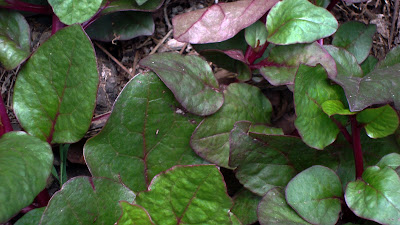A home garden is beneficial for your cooking and dining, home beautification and sanitation, and most important of all, your health. And, why not initiate gardening in your school and community?
(Please visit: Urban Gardening Models in this Blog)
Dr Abe V Rotor
Living with Nature School on Blog
Paaralang Bayan sa Himpapawid with Ms Melly C Tenorio
738 DZRB AM Band, 8 to 9 evening class, Monday to Friday
Lesson
- Rainy season will peak in July and August. Take advantage of the
season. There's natural fertilizer in the soil. Alternate sunshine and
rainfall favors plants to grow and develop fast. Have
these plants listed in your backyard, idle lots sidewalk, park, also
pots, cans and plastic containers. (See Home Garden Models)
Don't replace any plant that is useful or have potential value. Allow those that spontaneously grow like saluyot, spinach, alugbati talinum, gulasiman. They are wild and seasonal. Help them grow for your vegetable supply, herbal medicine, and animal feeds.
It's gardening time! And gardening is beneficial for your kitchen, home beautification and sanitation, and most important of all, your health. And, why not initiate gardening in your school and community?
It's gardening time! And gardening is beneficial for your kitchen, home beautification and sanitation, and most important of all, your health. And, why not initiate gardening in your school and community?
 Saba banana (Musa sapientum): multipurpose - leaves for food wrapper (suman, tupig, bibingka, kanin), packaging material (baon,
live or fresh fish and aquatic products), leaves as floorwax. Fruit,
ripe or green, excellent source of energy and nutrients, so with the
flowers (puso ng saging). Trunk as source of fiber and packing materials. Mushroom spawn under banana plants.
Saba banana (Musa sapientum): multipurpose - leaves for food wrapper (suman, tupig, bibingka, kanin), packaging material (baon,
live or fresh fish and aquatic products), leaves as floorwax. Fruit,
ripe or green, excellent source of energy and nutrients, so with the
flowers (puso ng saging). Trunk as source of fiber and packing materials. Mushroom spawn under banana plants. Coconut (Cocos nucifera):
It's the most important plant in the world when it comes to
productivity and variety of products. The nut is a complete food - young
or mature. There is no part of the plant that has no value. Walis tingting, leaves for mat, wall, and sinambong basket.
Trunk lumber outlasts most wood. Fiber from husk for cordage and net,
coir dust for soil conditioner. Flower spadix for ties and rope. Nectar
for beverage and lambanog. All you need is two to three trees at some
years age interval. A coconut tree can live productively up to fifty
years giving you at least a dozen nuts every month.
Coconut (Cocos nucifera):
It's the most important plant in the world when it comes to
productivity and variety of products. The nut is a complete food - young
or mature. There is no part of the plant that has no value. Walis tingting, leaves for mat, wall, and sinambong basket.
Trunk lumber outlasts most wood. Fiber from husk for cordage and net,
coir dust for soil conditioner. Flower spadix for ties and rope. Nectar
for beverage and lambanog. All you need is two to three trees at some
years age interval. A coconut tree can live productively up to fifty
years giving you at least a dozen nuts every month. Malunggay, the miracle vegetable. In
the province no home is without this small tree at the backyard or on a
vacant lot. The leaves, flowers, juvenile pods and young fruits of Moringa oleifera (Family
Moringaceae) go well with fish, meat, shrimp, mushroom, and the like.
It is one plant that does not need agronomic attention, not even weeding
and fertilization, much less chemical spraying. You simply plant an
arms length cutting or two, in some corner or along the fence and there
it grows into a tree that can give you a ready supply of vegetables
yearound. What nutrients do we get from malunggay?
Malunggay, the miracle vegetable. In
the province no home is without this small tree at the backyard or on a
vacant lot. The leaves, flowers, juvenile pods and young fruits of Moringa oleifera (Family
Moringaceae) go well with fish, meat, shrimp, mushroom, and the like.
It is one plant that does not need agronomic attention, not even weeding
and fertilization, much less chemical spraying. You simply plant an
arms length cutting or two, in some corner or along the fence and there
it grows into a tree that can give you a ready supply of vegetables
yearound. What nutrients do we get from malunggay?Here is a comparison of the food value of the fresh leaves and young fruits, respectively, in percent. (Marañon and Hermano, Useful Plants of the Philippines)
• Proteins 7.30 7.29
• Carbohydrates 11.04 2.61
• Fats 1.10 0.16
• Crude Fiber 1.75 0.76
• Phosphorus (P2 O 5) 0.24 0.19
• Calcium (CaO) 0.72 0.01
• Iron (Fe2O3) 0.108 0.0005

 Atsuete or anatto (Bixa orellana) is the best natural food color and adjunct, in cooking paella, upo, noodles,
frog, etc. It is used extensively in imparting color of cheese and
butter, also yogurt. Natural cosmetics are made from atsuete. Flowers
are colorful in the garden. Its a small tree, provides good shade and
does not attract insects.
Atsuete or anatto (Bixa orellana) is the best natural food color and adjunct, in cooking paella, upo, noodles,
frog, etc. It is used extensively in imparting color of cheese and
butter, also yogurt. Natural cosmetics are made from atsuete. Flowers
are colorful in the garden. Its a small tree, provides good shade and
does not attract insects. Kamias: Once in a while try sinigang with
kamias, specially fish. It takes out the fish smell. ITs dourness is
distinct from vinegar, tamarind, and kalamansi. Just don't indulge too
much because the sour taste is oxalic acid which is deficient in
calcium. But oxalic acid is best for cleaning tiles and utensils. Its
effective in cleaning the drain. Bees often visit its flowers.
Kamias: Once in a while try sinigang with
kamias, specially fish. It takes out the fish smell. ITs dourness is
distinct from vinegar, tamarind, and kalamansi. Just don't indulge too
much because the sour taste is oxalic acid which is deficient in
calcium. But oxalic acid is best for cleaning tiles and utensils. Its
effective in cleaning the drain. Bees often visit its flowers. Tanglad or lemon grass as food condiment for kuhol and lechon. As deodorizer, it imparts pleasant smell, absorbs or masks unplesant odor in bathroom and kitchen.
Tanglad or lemon grass as food condiment for kuhol and lechon. As deodorizer, it imparts pleasant smell, absorbs or masks unplesant odor in bathroom and kitchen. Aloe vera is
a used mainly as hair conditioner, stimulating hair growth, and giving
shine and smoothness on dull and rough hair. It is mixed with fruit
juice. Commercial fruit juice products use aloevera as solids or pulps.
As home remedy, it is used to treat minor burns.
Aloe vera is
a used mainly as hair conditioner, stimulating hair growth, and giving
shine and smoothness on dull and rough hair. It is mixed with fruit
juice. Commercial fruit juice products use aloevera as solids or pulps.
As home remedy, it is used to treat minor burns. Gumamela: It
comes in more than a dozen varieties. Other than its all year round
flowers that make a garden attractive and home of butterflies, the
gumamela serves as home remedy for boil and mumps. Young petals are also
cooked as vegetable
Gumamela: It
comes in more than a dozen varieties. Other than its all year round
flowers that make a garden attractive and home of butterflies, the
gumamela serves as home remedy for boil and mumps. Young petals are also
cooked as vegetable Alugbati is
a climber, and lives for some years providing a continuous supply of
shoots or tops cooked as vegetable, best with mungo. It is the cheapest
and readily available source of iron for the family.
Alugbati is
a climber, and lives for some years providing a continuous supply of
shoots or tops cooked as vegetable, best with mungo. It is the cheapest
and readily available source of iron for the family. Pandan mabango:
Aromatic, its leaves improve the taste of food. Put a leaf in a pot of
old rice (laon) before cooking to take out the moldy taste and smell.
Pandan leaves make a refreshing drink with any fruit juice. Try sago, gulaman and
pandan. Pandan cake? It breaks the monotony in bread products. First
prepare a layer of pandan leaves like mat before cooking fish paksiw will taste. Clean kitchen utensils and tiles with crushed leaves. A unique volatile oil present only in pandan mabango make this plant a favorite of housewives .
Pandan mabango:
Aromatic, its leaves improve the taste of food. Put a leaf in a pot of
old rice (laon) before cooking to take out the moldy taste and smell.
Pandan leaves make a refreshing drink with any fruit juice. Try sago, gulaman and
pandan. Pandan cake? It breaks the monotony in bread products. First
prepare a layer of pandan leaves like mat before cooking fish paksiw will taste. Clean kitchen utensils and tiles with crushed leaves. A unique volatile oil present only in pandan mabango make this plant a favorite of housewives .
These are also a must to have in the garden:
- Onion (shallot or bulb)
- Papaya
- Guava
- Sorosoro (karimbuaya Ilk)
- Oregano
- Lagundi
- Sambong
- Lemon or kalamansi
- Luya (ginger)
- Sampaguita

Don't
forget to build a garden pond and plant around it water-loving plants.
Pond water becomes green with algae. It is the best natural fertilizer,
specially if you are raising tilapia or hito or Pangasius catfish.
- Kangkong
- Gabi
- Sugarcane for chewing
Here are some suggested plants to include.
- Kutchai (photo, right)
- Siling labuyo
- Kamote
- Yerba buena (mint)
- Ampalaya
- Tsaang Gubat or wild tea (photo, top)

Just don't overload your garden. Give yourself a break. Don't be a slave to your garden, so to speak. By the way even without our knowing it, annual plants simply sprout in the garden. Many of these are seasonal. While most are so-called weeds, there are food plants that grow spontaneously like saluyot, amaranth of kolitis, wild yam, wild ampalaya, talinum, and at least a dozen more if you are living in a fertile and well drained area.
A home garden actually is a miniature representation of a large farm. It is typical in size for a family, as small as 10 square meters to one hectare. The garden is an integral part of the home. It aims at self-sufficiency, environmental friendliness, and health-promoting, and ultimately, at living in a Home, Sweet Home with Nature.~

No comments:
Post a Comment